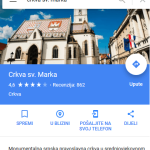If Google Maps can learn Croatian, so can you.
Google Maps has become one of the most helpful mobile applications of our time, used by millions of people around the world. Do you need to get somewhere you’ve never been before? Boom, Google Maps will take you there in no time. Are you not sure which bus lines will move you from point A to B? Don’t fret, Google will not only tell you which bus you need, but they’ll even tell you when it is expected. And the best part? This app also does a decent job navigating tourists (and locals) through the twisted, hidden, and always confusing alleyways inside of Diocletian’s Palace. I’ve lived in Split for three years now, and yes, I still need to turn on my trusted maps on occasion. What can we say, Google Maps is always by our side.
A web mapping service developed by Google back in 2005, Google Maps offers users street maps, satellite imagery, 360-degree panoramic views, traffic in real time, and they’ll even plan your route for you depending on how you are traveling – by car, foot, or public transport. We hear bicycle transport is in the works, too. Because I am not really sure anyone can say a bad thing about the application itself, something that could pose a problem for users is the fact that Google Maps was available in specific languages – and Croatian wasn’t included on that list. Well, that was until a few days ago.
As of March 27, 2018, Google Maps has learned another 39 new languages for their over 1 billion users across the globe. On the company’s blog, Google announced the addition of these languages that are spoken by an estimated 1.25 billion people worldwide. Apart from the Croatian addition, Google has also added Afrikaans, Albanian, Amharic, Armenian, Azerbaijani, Bosnian, Burmese, Czech, Danish, Estonian, Filipino, Finnish, Georgian, Hebrew, Icelandic, Indonesian, Kazakh, Khmer, Kyrgyz, Lao, Latvian, Lithuanian, Macedonian, Malay, Mongolian, Norwegian, Persian, Romanian, Serbian, Slovak, Slovenian, Swahili, Swedish, Turkish, Ukrainian, Uzbek, Vietnamese, and Zulu.
Localization for such frequently used programs is never easy, especially if there are a total of 6,909 living languages in the world according to the Ethnological Catalog. Swahili, for example, is used by eight percent of the African continent, while nine percent of Europeans use Turkish.
Google Maps started its English version in 2004, while support for other languages has become available over time. These new languages will reach the desktop and mobile versions of Google Maps, meaning all iOS, Android, Mac, and Windows users.
Activating this new feature, and more or less of Google’s novelties, will not be available to everyone at once, but will reach the population gradually.
Source: Dalmacija Danas









